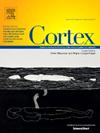Earlier finish of motor planning in the premotor cortex predicts faster motor command in the primary motor cortex: Human intracranial EEG evidence
IF 3.3
2区 心理学
Q1 BEHAVIORAL SCIENCES
引用次数: 0
Abstract
The human motor system operates under hierarchical control during finger movements. The non-primary motor cortex (premotor cortex, PM, and supplementary motor area, SMA) organizes motor planning, while the primary motor cortex (M1) is responsible for motor execution. We utilized the high temporal and spatial resolution of intracranial EEG (iEEG) to investigate how the temporal dynamics of high-gamma oscillations in these hierarchically organized motor sub-regions, during both pre-movement planning and motor execution, correlated with reaction times (RTs) in a cued finger movement task. Our results showed that high-gamma power in PM, SMA, and M1 activated sequentially. More importantly, the sustained high-gamma activation in the non-primary motor cortex and the peak latency of high-gamma power in M1 significantly predicted RTs. Specifically, the faster the activation of the non-primary motor cortex returned to baseline, the faster the motor command in M1, resulting in shorter RTs. Furthermore, pairwise phase coherence between motor areas revealed that more sustained connectivity correlated with longer RTs. These findings illustrate the relationship between the temporal profiles of high-gamma activity in human motor areas and response performance.
运动前皮层提前完成运动计划预示着初级运动皮层更快的运动命令:人类颅内脑电图证据
人的运动系统在手指运动的分层控制下运作。非初级运动皮层(运动前皮层,PM和辅助运动区,SMA)组织运动计划,而初级运动皮层(M1)负责运动执行。我们利用颅内脑电图(iEEG)的高时间和空间分辨率来研究在运动前计划和运动执行期间,这些分层组织的运动子区域的高伽马振荡的时间动态如何与提示手指运动任务中的反应时间(RTs)相关。我们的结果显示,PM、SMA和M1的高伽马功率依次激活。更重要的是,非初级运动皮层的持续高伽马激活和M1高伽马功率的峰值潜伏期显著预测RTs。具体来说,非初级运动皮层的激活越快恢复到基线,M1中的运动命令就越快,从而导致更短的RTs。此外,运动区域之间的成对相位一致性显示,更持久的连通性与更长的RTs相关。这些发现说明了人类运动区域高伽马活动的时间分布与反应表现之间的关系。
本文章由计算机程序翻译,如有差异,请以英文原文为准。
求助全文
约1分钟内获得全文
求助全文
来源期刊

Cortex
医学-行为科学
CiteScore
7.00
自引率
5.60%
发文量
250
审稿时长
74 days
期刊介绍:
CORTEX is an international journal devoted to the study of cognition and of the relationship between the nervous system and mental processes, particularly as these are reflected in the behaviour of patients with acquired brain lesions, normal volunteers, children with typical and atypical development, and in the activation of brain regions and systems as recorded by functional neuroimaging techniques. It was founded in 1964 by Ennio De Renzi.
 求助内容:
求助内容: 应助结果提醒方式:
应助结果提醒方式:


